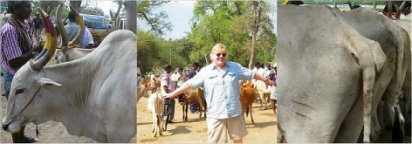On the road out of Pondicherry we saw a huge
group of people with cows and a produce market. It was an auction sale.
Sanjay stopped the bus and led us out for a photo-op, shouting the warning,
"Donít step on the shit!" He mentioned that cattle can run from 8000.00
rupees to 20,000.00, depending on the genes and potential production of
calves, and ability to do heavy farm work. Some are sold as meat for Mumbai
for those not following religious restrictions.
Bill was soon lost among the cows while Sue-On went
looking for fruit. She stopped at a vendor whose mangoes appeared ripest
but she ran into a bit of a language problem when attempted to by two mangoes.
By the end of the transaction she had paid 100 rupees and walked away with
six mangoes.
The whole episode was reminiscent of an episode in
a Vancouver Chinatown restaurant many years ago. Bill, thinking that
Sue-On would understand the dialect, went to the washroom and left her
to order. She was confused by the dialect, and when he came back, the whole
table was heaped with dim sum! The older vendors loved having their pictures
taken and were happy when they were shown the pictures. The jackfruits
were huge, and the mounds of tamarind looked scary, almost like scorpions.
Rural village cattle markets are a major social event
for all the people in the region and provide visitors with a beautiful
glimpse into rural life. Mixed in with the herds of cattle on display are
sellers of farm products, fruit, vegetables and other foodstuffs.
Village folks from as far as a 40 km radius came to
this market to trade their cattle. Some of them would have walked for over
two days to get to the cattle fair, hoping to get a fair deal for their
prized cattle. The whole market area was alive with activity. Prospective
buyers wandered about "window shopping" -- inspecting the cattle before
zeroing in on the one they would take home.
Cattle are really part of the farmerís family. They
raise them with as much love and care as they give their own children.
The importance of cattle to rural India is is hard to overstate -- there
is an endearing bond between the farmer and his animals. For small time
farmers, who can't afford to own tractors, the bulls are their only means
to earn a livelihood on their farms.
The bulls are the celebrities of the cattle fair Ė
they have to look their best and great care is taken to decorate them.
The farmers make every effort to feed the cattle well and keep them happy
while waiting at the market. The teeth are the best indicators of the bullís
age. Buyers also inspected the shine in the bullsí eyes and get a feel
of their muscles.
We were told that bulls born by artificial insemination
are single coloured Ė white, brown or black. Only the ones conceived naturally
are black and white in colour.
Some of the negotiations took place under shawls shared
by the seller and buyer. The sellers don't want to reveal how low they
are willing to negotiate. The buyer and the seller put their hands under
the shawl to carry on non-verbal, touch-and-feel negotiations. Shouts from
the onlookers urged the deal to go through. The buyer patted the bull when
the deal was finalized.





























